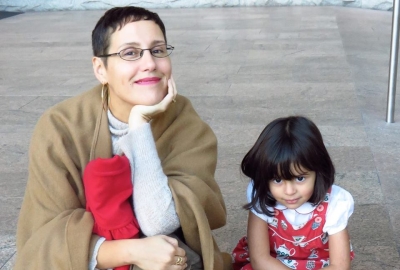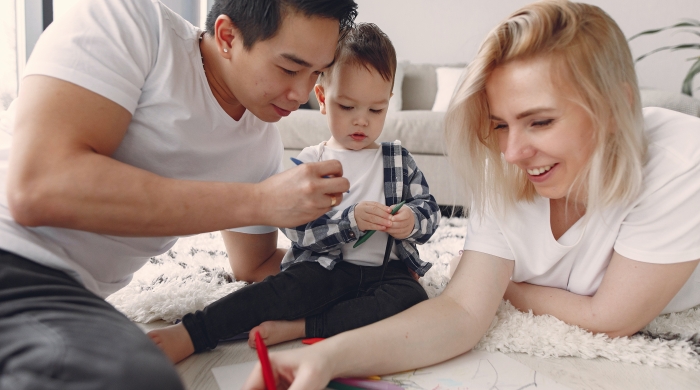
This post is also available in Spanish/Esta publicación también está disponible en español.
As part of my collaboration with DREME, a cross-university effort on the Development and Research in Early Math Education, I have visited about seventy-five Spanish-English bilingual families of young children, mostly immigrant families living in New York City. I have observed parents interact with their preschool-aged children in different tasks and chatted with them regarding their ideas about math. A few of those visits stand out for me. There was Angélica, the mother of her 4-year-old boy, originally from Mexico, who told me that: “Las matemáticas son para personas inteligentes. Yo no hago matématicas. Mi niño sí hace matemáticas. Le gustan.” (Math is for intelligent people; I don’t do math. My son, he does do math; he likes it). There was also Celerina, the mother of 4-year-old girl and also from Mexico, who said: Las matemáticas están en todo. Yo las uso en mi trabajo como cajera, cuando cocino y voy a hacer el mandado, y cuando tengo que pensar en el tiempo y en todo lo que tenemos que hacer en el día.” (Math is everywhere. I use it in my work as a cashier, when cooking and shopping, and when figuring out my family’s schedule). While Angélica’s and Celerina’s attitudes towards math differed, during our visit they both used math talk with their children, albeit to differing degrees.
In reflecting upon Daniel and Jacob’s piece on supporting math at home during these unprecedented and trying times, I want to reach parents like Angélica and Celerina, who have different attitudes towards math. For them, I want to underscore the simple fact that in the same way that language permeates all aspects of our lives, math is embedded in our everyday routines. The math that is integrated into our daily lives is important for children as it plays a foundational role for what they will be asked to do in school. So whether you share Angélica’s or Celerina’s attitudes, what can you do at home now?
The first step is to uncover the math you are already doing. We sort clothes based on colors and type (e.g., clothes and kitchen rags) to be laundered separately. In doing so, we are classifying objects based on similarities creating sets. When doubling a recipe or figuring out how much medicine to give to our baby based on her weight, we are engaging in mathematical operations. When tidying and putting away our children’s toys we make decisions where things go relying on both measurement and spatial thinking. When knitting and weaving, we are creating patterns (two lines of red, one blue, two red, one blue) a skill that will be needed for algebraic thinking. In other words, to support young children’s early math at home, you do not need to have or get any special “math” objects. As Daniel and Jacob’s piece points out “you already have the tools. “ These can be toys, but they can also just be part of your household because we all do math.
The second step is to include your child in these math-related activities that frankly we all need to do. Plus young children love to help out! They can sort piles of laundry into whites, dark colors and mixed colors. They can help figure out how many plates and silverware are needed when setting the table, or they can help you in organizing the toy box by colors, shapes, or types. Having children participate in these math-rich activities not only develops their early math skills, but also their sense of autonomy!
The third step is to talk about the math. Daniel and Jacob provide a good review of the research that underscores the positive relation between parental math language and children’s early mathematical development. So, when engaging in these everyday math activities, as Daniel and Jacob note, count objects, and talk about numbers, shapes and space. But also compare and measure objects by size and weight, point out and talk about patterns, in other words, talk about what you are doing! Perhaps most importantly ask questions that prompt your child to solve everyday mathematical problems. So when setting the table, you can say: “Fernanda, we need three plates”. Or you can say: “Fernanda, count how many we are and tell me how many plates I need to get from the cupboard.” Both instances have math language, but the latter allows children to engage in mathematical problem solving.
The fourth and final step is to use the magic word. Remember that math is about solving problems and that there are many ways to solve one problem. Asking why and allowing your children to tell you how they figured out the answer, whether it was right or wrong, opens a window into their thinking and allows you to support their mathematical skills even further.
In short, children’s early math skills develop in the context of their everyday lives when they have varied opportunities to engage in mathematical thinking and to apply this knowledge in real and meaningful ways. No matter our individual circumstances, we all have what is needed to support this early math development. In much the same way that talking, singing, and reading with young children support early literacy development, uncovering, using, and talking about everyday math support their early mathematical skills. For family math ideas check out this month’s DREME newsletter on Fun & Easy Math Activities to do at Home! ¡Hay una en español!
Dr. Gigliana Melzi is a professor and researcher at NYU. Dr. Melzi's work focuses on the intersection of cultural and linguistic practices and its relation to children's early learning and development. Born and raised in Peru, Dr. Melzi now lives with her family in NYC and is raising her daughter bilingually.
Learn More
Taking Deep Breaths and Counting to Ten
IES-PIRT fellows and doctoral students in the Developmental Psychology program Daniel Suh and Jacob Schatz offer insight, suggestions, and resources for parents who now must become math teachers at home due to COVID-19.


